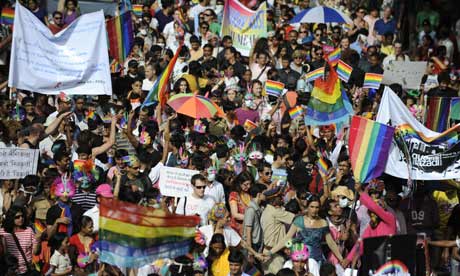A critique of Pride: more responses

Thanks to the readers of Orinam.net for sharing your thoughts on Neel’s post about pride celebrations in India. Here is Anis Ray Chaudhuri’s response to Neel’s critique.
Neel’s post raised a storm in my head. Trying to settle down my responses and type them in order –
1. There is no universal conclusion on the origin of same-sex desire. Whether we were born gays or chose to be gays is yet a subject of debate and research. I wonder why we don’t debate whether the straight people were born straight or chose to remain so. Let the scientists find out the ‘straight gene’!
2. We join the parade not merely because we are proud to be gays (of course I’m proud to be gay since I consider myself special. There are differences between being abnormal and being special) but more so because we are proud of achieving the courage and confidence to hit the streets wearing our desires on our sleeves. Instead of remaining in the closets – fearing the society’s ‘perceptions’ and succumbing to the internalized homophobia caused by various expressions of such social ‘perceptions’, we are able and empowered enough to assert our rights to be different (not abnormal) – isn’t that an achievement? And didn’t Neel mention that one could be proud of one’s achievements?

3. When we claim that we are normal we mean we are normal and not ‘normal according to social perceptions’. First we need to understand the differences between being normal and subscribing to normativity. Then only we could fight the social conspiracy of imposing its norms on us in the name of normalcy. We are normal since centuries of conspiracies have failed to prove that we are sick physically or psychologically, we are normal since we are existing in all ages in every class of every society, we are normal since our desires are normal – found in all other creatures as their natural instincts. To prove that we are normal we don’t need to satisfy anyone else’s whims or constructed fancies and definitions.
4. Assertion of non-normative sexualities and/ or gender non-conformities is a socio-political struggle and that could have various strategies. But we need to keep in mind that like every other struggle there will be conflicts. The institution of hetero-normative patriarchy and its agents will never leave a single inch of space to us of their sweet will. We have to wrest that out. One good strategy could be, as suggested by Neel, to hit the streets in ‘respectable’ ‘normal’ attires in the most ‘decent’ way and distributing leaflets with a smiling friendly face. Other strategies could be making ourselves visible in everyday lives as individuals, couples, groups to prove that we are responsible, respectable and normal human beings. Organising LGBT events and socio-cultural enterprises to spread awareness and to sensitize are also important strategies. But I sincerely doubt whether even these strategies would have worked with ‘those guys at the Empire’. Thugs will remain thugs and you need to have a separate strategy to deal with them. On one hand start organised straight bashing retorting gay bashings and on the other hand capitalize on the bruises and wounds, lodge complaints with law-enforcement agencies, get the incident documented and mobilise wider protests. If everything is fair in love and war, it is even more fair in the war for the right to love! No doubt its a war and blood will spill. We need to prepare ourselves for that.
“If everything is fair in love and war, it is even more fair in the war for the right to love!”
5. If I am not entirely wrong, Kinsey3 referred to me. Yes, I walk in Kolkata Pride in starched dhoti-kurta singing Rabindrasangeet – not because I want to make the mainstream institution happy. I do that as a well-planned socio-political statement. At the same time I firmly believe the camp, boisterous attires of my friends make equally, if not more, powerful socio-political statements. And believe me, this middle-class, straight-acting, dhoti-clad bhadralok raised the slogan ‘garv se kaho hum gandu hein’ intentionally to give the onlookers a cultural shock and also to reclaim the word stigmatised by the mainstream.
We need to fight all out against all institutionalized oppressions of human right to freedom of choice and self-expression – unabashed, without any compromise and fear.
Statutory disclaimer: The word ‘gay’ has been used here in the loose manner similar to the uneducated milieu, though that meant every LGBTQHIKM . . . and anybody and everybody who is confidently practicing non-normative sexualities and/ or gender non-conformities.





// If everything is fair in love and war, they are even more fair in the war for right to love! No doubt its a war and blood will spill. We need to prepare ourselves for that.//
What a vision! Loved reading it, beautifully written.
This was a good post, thoroughly enjoyed reading it. I have been a part of the Kolkata pride walk for several years, and every year I hear comments like “why do some people need to dress or behave like that”, usually directed against people in drag. There even have been organised efforts to ban certain gestures (like the ‘thikri’ or loud clap used by Hijras and some Kothis, Trans-identified people, etc.) from the pride walk on grounds of their alleged “indecency” or disreputability. All of these testify to how much we often internalise the norms of society and strive to appear as “normal” by those standards, rather than critiquing and transforming them. And a lot of these standards of so-called normalcy are not only homophobic/transphobic but also classist, setting a standard of “decency” and “respectability” as per middle or upper class norms.
Orinam Editors Note: See Aniruddha Dutta’s insightful essay Kotis and Sexual Politics in Eastern India published in Samar Magazine (2008) for more details.